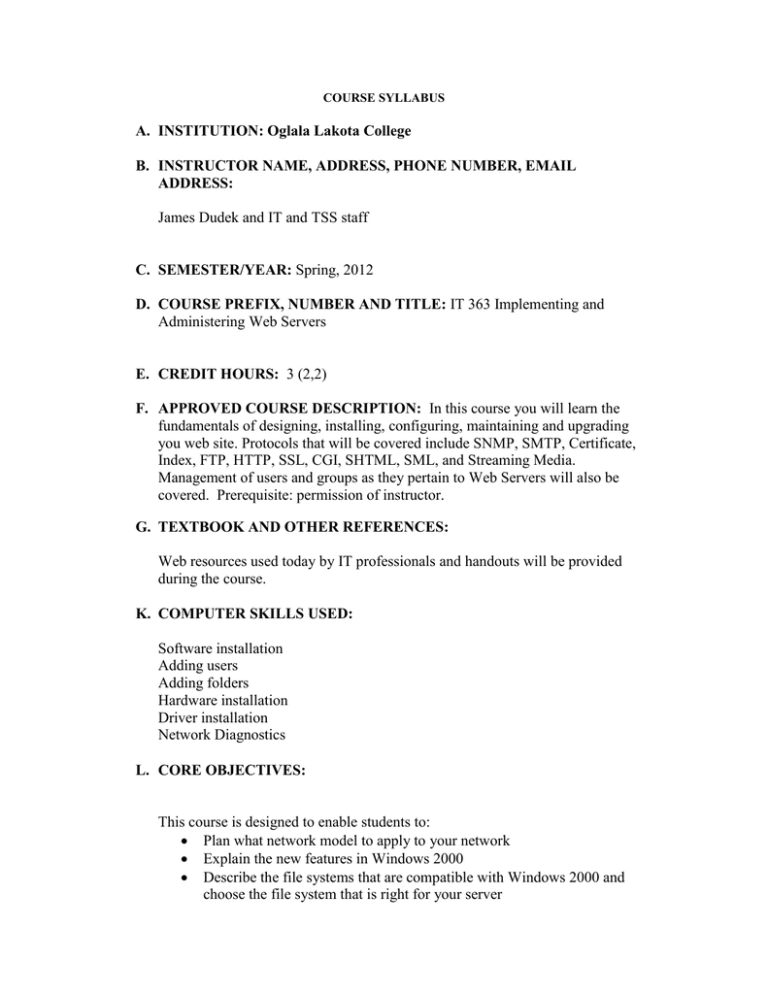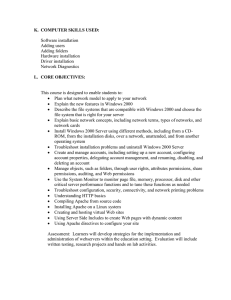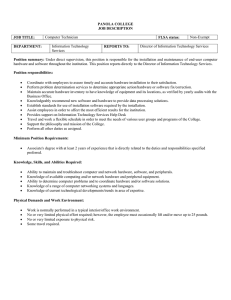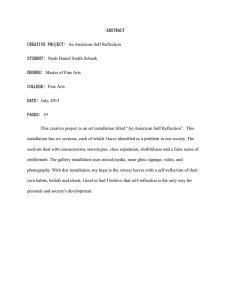James Dudek and IT and TSS staff
advertisement

COURSE SYLLABUS A. INSTITUTION: Oglala Lakota College B. INSTRUCTOR NAME, ADDRESS, PHONE NUMBER, EMAIL ADDRESS: James Dudek and IT and TSS staff C. SEMESTER/YEAR: Spring, 2012 D. COURSE PREFIX, NUMBER AND TITLE: IT 363 Implementing and Administering Web Servers E. CREDIT HOURS: 3 (2,2) F. APPROVED COURSE DESCRIPTION: In this course you will learn the fundamentals of designing, installing, configuring, maintaining and upgrading you web site. Protocols that will be covered include SNMP, SMTP, Certificate, Index, FTP, HTTP, SSL, CGI, SHTML, SML, and Streaming Media. Management of users and groups as they pertain to Web Servers will also be covered. Prerequisite: permission of instructor. G. TEXTBOOK AND OTHER REFERENCES: Web resources used today by IT professionals and handouts will be provided during the course. K. COMPUTER SKILLS USED: Software installation Adding users Adding folders Hardware installation Driver installation Network Diagnostics L. CORE OBJECTIVES: This course is designed to enable students to: Plan what network model to apply to your network Explain the new features in Windows 2000 Describe the file systems that are compatible with Windows 2000 and choose the file system that is right for your server Explain basic network concepts, including network terms, types of networks, and network cards Install Windows 2000 Server using different methods, including from a CD-ROM, from the installation disks, over a network, unattended, and from another operating system Troubleshoot installation problems and uninstall Windows 2000 Server Create and manage accounts, including setting up a new account, configuring account properties, delegating account management, and renaming, disabling, and deleting an account Manage objects, such as folders, through user rights, attributes permissions, share permissions, auditing, and Web permissions Use the System Monitor to monitor page file, memory, processor, disk and other critical server performance functions and to tune these functions as needed Troubleshoot configuration, security, connectivity, and network printing problems Understanding HTTP basics Compiling Apache from source code Installing Apache on a Linux system Creating and hosting virtual Web sites Using Server Side Includes to create Web pages with dynamic content Using Apache directives to configure your site Assessment: Learners will develop strategies for the implementation and administration of webservers within the education setting. Evaluation will include written testing, research projects and hands on lab activities. M. Program Objectives , met, in part, through the course: Develop the skills needed to implement and administer webservers. Understand the capabilities of the webserver, its impact on education, business, industry and government; and will be able to adapt to, understand, evaluate and make use of new and emerging innovations in webserver technology. Be proficient in the use and application of webserver software. N. INSTRUCTIONAL METHODOLOGIES: 1. Lectures/Demonstrations/Guest Speakers: 2. Labs: 3. Implement and Administer an Operational Webserver O. COURSE OUTLINE: Networking with Microsoft Windows NT 2000 Server Planning Network Protocols and Compatibility Planning for Server Hardware Compatibility, Disk Storage, and Operating System Requirements Planning the Active Directory Implementation Server Installation Server Configuration Configuring Storage, Backup, and Performance Options Managing the Server and Clients through Accounts and Groups Managing Server Folders, Security, and Software Installation Printer Installation and Management Server Monitoring and Optimization Network Monitoring and Tuning Troubleshooting P. EVALUATION PROCEDURES: Grading: Quizzes Group Documentation Project Lab Assignments Final Project Total Grading Scale 90-100% A 80-89% B 70-79% C Below 70% F 10% 10% 30% 50% 100% Attendance Policy: Students will be expected to attend all class sessions


